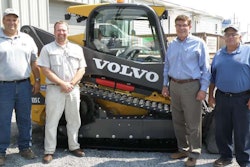Thomas “Tommy” Burleson
Johnson City, Tennessee
This agile firm keeps a sharp eye on trends that can impact tomorrow’s jobs
By Marcia Gruver Doyle
When Tommy Burleson calls his firm “a typical after-the-war construction startup,” he means World War II, underlining just how long his third-generation firm has been around. But don’t think longevity translates into relying on tradition. The 60-year-old Burleson has a keen eye on national trends, especially ones that can translate into local business opportunities.
Take, for instance, his company’s present position as owner’s representative for Johnson City, Tennessee. Burleson credits his involvement with the Associated General Contractors of America – he’s served in several leadership positions at the national level and has been president of the Tennessee branch – with his exposure to the owner’s representative concept.
“One of our strong points has always been our ability to manage jobs,” Burleson says. When Johnson City announced it was ready to build $70 million in community projects, Burleson made them a proposal: acting as an owner’s representative, his firm would oversee the city work. While Burleson Construction would get an owner’s representative fee, it also meant it couldn’t bid on the work. The company is now managing five city projects that involve four architectural firms and five contractors.
The strategy worked out well in today’s fiercely competitive market. The firm could depend on the fee, a factor that became critical as it saw its normal volumes constrict by 60 percent. “This is the first time since we’ve been in business we’ve gone more than two years without hiring anyone,” Burleson says.
But the company has been able to ride the downturn by tamping down hard on costs and noticing where others were making mistakes. “A lot of companies did work based on what their cash flow needs were,” Burleson says, “not on what the job was worth. Fortunately, we didn’t have to do that, because there’s not always a next job.”
Involvement creates opportunities
One company foundation that withstood all of these recent tests is its AGC involvement. Burleson sums up what he gets back from his association dues this way: “What’s a relationship worth? What’s a new idea worth? Just being involved in the state group’s self-insurance trust has more than saved what our dues have cost us.”
In addition to the owner’s representative strategy, Burleson also credits his AGC involvement with two other initiatives his company has started: BIM (Building Information Modeling) and LEED (Leadership in Energy and Environmental Design). The company used both approaches on one of its premier projects, local Milligan College’s Gilliam Wellness Center, opened in 2010.
Burleson saw early that BIM, which converts architectural drawings into three-dimensional virtual models, would help this firm get work. “You can build in a digital environment for the first time, instead of out on the jobsite, so it’s easier to catch mistakes,” he says. “We can take this out in the field, and show everyone the building model on a laptop. It’s like having 20/20 vision.” There is a learning curve, however. Burleson estimates it took 18 months for his firm to get fully comfortable with the process.
A Gold-level building
The company started its adoption of LEED, a nationally accepted environmental building benchmark process, in 2008. Now four Burleson professionals are LEED accredited – including Burleson. The Gilliam Wellness Center achieved a LEED Gold-level certification by the building team paying attention to and earning performance credits in five categories. For example, the company estimates it was able to divert 80 percent of the project’s landfill waste by sorting and processing normal jobsite trash – sheet rock, card board, etc.
Pervious pavement, automatic shades that drop as the sun rises, recycled vinyl flooring and movement-sensitive lighting all contributed to the building’s LEED certification. Burleson says the most challenging part of doing a LEED building, however, is educating a workforce that’s used to doing things the old way – such as tossing everything out and putting all discards into one pile. So he drove the point home by treating his crew to lunch, emphasizing it was paid for with part of the money the firm saved on landfill costs.
Building excellence
A Clemson University ROTC stint has lead Burleson to 30 years of U.S. Army active and reserve duty, much of it as a combat engineer, including a deployment during Desert Storm. “Patience is something a couple of my deployments have taught me, and patience is a tough thing in our business,” he says with a laugh.
Burleson is a natural leader, according to Wes Stowers, chairman of Stowers Machinery, the local Caterpillar dealer. Not only is he a client of Stowers, he also built the dealer’s tri-cities branch in Kingsport, Tennessee, including the 1993 original building and a 2000 addition. “He did everything he said he would do, and when we added on, we went right back to him,” adds Stowers. “You can’t tell that the two sections weren’t built together.”
The contractor also has a heart for community involvement. His son T.J.’s death at 15 of Ehlers-Danlos syndrome prompted Burleson to lead the volunteer charge to build the community’s Ronald McDonald House. And he’s gearing up to spearhead a similar effort for a hospice near the local Veterans Administration hospital.
Making use of both his Clemson University BS in building construction and his graduate degree in the School of Hard Knocks, Burleson teaches a three-day leadership class each year for AGC branches in California. He also has a return local speaking engagement closer to home.
“I think so much of his ethics, I have him speak to my students on that very subject,” says Jeremy Ross, associate vice president of the Eastern Tennessee State University Foundation, and university professor. “When I oversee a project involving private funds – and I can use any contractor I want – I always use Tommy because I know the end result will be a building of excellence.”
Burleson Construction
Year started: 1945
Number of employees: 20
Average annual revenues (past three years):
$3 to $5 million
Markets served: commercial, institutional and industrial buildings; water and wastewater
Three generations
In 1945, J.R. Burleson and his sons Grover and Reno started Burleson Construction, first concentrating on residential work. The firm incorporated in 1971, and moved into its present facility in 2003. Reno still serves as chairman of the board. Grover “Skip” Burleson, Burleson’s cousin, is vice president of operations, and works with the firm’s project managers to schedule equipment and labor. He also oversees the company’s water and wastewater projects.
Compact arm twisting
Burleson primarily owns compact equipment, including a compact excavator he had to do some arm-twisting to get his operator to run. “We had a nasty job where we had to put in footings on a confined slope,” Burleson says. Used to a backhoe, the operator was reluctant to try out the compact excavator. “But on that job he found out he could do so much more with the excavator than he could a backhoe. He became a firm believer.”












